1991-1995 Cizeta Moroder V16T
The Forgotten 90s Supercar
Article by Ian Kuah
Photos by Tim Andrew
Ian Kuah takes us back to the peak of the supercar boom when he visited a small factory in Modena. It was there that he interviewed an optimistic constructor, Claudio Zampolli, who had no idea that the financial world was about to go bang - and take his project with it.
I will never forget the day. I was sitting in the office in late 1988 when a package arrived from America. It contained a press release and some studio photographs of a sensational looking mid-engined supercar from a manufacturer none of us had ever heard of. It also contained an invitation to the unveiling in Los Angeles.
In fact, the car was not a working entity at that time. The press launch in December 1988 presented the mock-up and many design sketches. The first production car was black and was shown at Geneva in 1991 before going to its owner in Singapore. Full production began some six months later. I did not go to Los Angeles in 1988, but in the summer of 1992, Cizeta was high on my hit list when I undertook a pilgrimage to Modena, Mecca of the Italian supercar.
I had been at Maserati the day before and cizeta was just a few streets away off the same main road. In stark contrast to the Maserati factory, Cizeta's unassuming looking building was midway down a street that combined low rise office building with factory units. It was hard to imagine that futuristic looking supercars emerged from this building every so often.
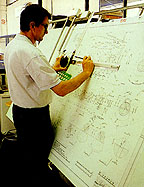
I was met by Claudio Zampolli, Mr. Cizeta (pronounced Chey-Zeta, the way the initials CZ, Zampolli's initials, are spoken in Italian) himself. Totally laid back in the typical Italian way, Zampolli sat me down in his office and recounted his story in fluent English, with a Transatlantic twang. No surprise really, as one of the first things he revealed was that he and his family had lived in Los Angeles for many years.
"Before that, I was a test and development engineer at Lamborghini, where I worked on the Miura and Countach," he explained. "But I was looking for an opportunity to run my own show, and decided to go to America." A dyed-in-the wool petrolhead, Zampolli put his intimate knowledge of Italian supercars to good use. Setting up an exotic car dealership on Wilshire Boulevard in west Los Angeles, he sold and serviced Ferraris, Lamborghinis, and other Italian supercars.
"This was quite and education in the real world," he explained. "At Lamborghini, my job had been to develop and test. Here, I had to listen to customers complain about reliability, and mechanics complain about how difficult the cars were to work on." So when the first thought about building his own car started to percolate in the closing months of the 1970's, these practical lessons were very much part of the design process.
A Well Kept Secret
To avert this, Zampolli kept thing secret to avoid such negative comments. "I didn't want to be knocked down before building it," he said. "The only people who knew about the car were the craftsmen working on the prototype. It was such a big secret that even my family, who had to put up with my frequent trips to Italy, were not privy to the project! When the mock-up was ready, I suddenly said that I was launching a 16-cylinder sportscar. Even the Italian press did not know!"
So why 16-cylinders? If the car had 12-cylinders, it would be no big news. "As a small and exclusive car maker, I had to be different," Zampolli explained. "16 cylinders is very exotic, and the engine is strong and torquey. It is also very docile. You can drive around town in fourth gear. It is like driving an auto."

A visible show of pride and allegiance to Italy and Modena is shown in the Cizeta company logo. For this, Zampolli adopted the city of Modena's colours, blue and yellow. The wolf's head logo is symbolic of the Tiberian she-wolf which fed Romulus and Remus, the orphaned children of Mars who founded Rome. To this, he added his own initials, CZ. The raised parts of the cam covers and the long intake plenum are also picked out in blue and yellow.
Unlike the Ferrari F40 and Bugatti EB110 of the same generation, the unique 16 cylinder Cizeta uses no Kevlar in its construction. Its space-frame chassis was built the tried and tested way used by Italian supercar makers for 40 years. Elliptical chrome molybdenum steel tubing was welded together by hand to make up the main frame. The plumbing, water, brake lines and electricals are contained in the 72mm diameter backbone tube that runs down the centre of the chassis. The sleek aluminium body which clothes the structure was made in Turin. The car incidentally, has a flat underbody.
The only carbon fibre you will find on this car is used for the dashboard panel. Dashboard supports are fabricated in aluminium rather than glass fibre, because leather on GRP eventually creeps. The bulkhead between the engine and cabin is double-skinned for sound and heat insulation. It works so well that you can hold a normal conversation at 110mph.
Class Craftsmen
The tooling was made in-house along with the jigs. All the engine work was done by local workshops in Modena. "There are lots of small workshops around here that will make you half a dozen of something rather than 1,000," Zampolli explained. "These are people well versed with F1 or just exotic sports cars. Most of the craftsmen in my company have at least 30 years experience with specialist cars, and many I knew from Lamborghini." Chief engineer and head of engine development was Oliviero Pedrazzi; Archille Benveni and Lanose Bronzatti were the chassis men and the master fabricator was Giancalo Guerra. All were recruited from Lamborghini.
"All the work is done here except machining. We assemble the chassis, suspension, sheet metal, engine components and upholstery," Zampolli explained. "Machining is contracted to a precision workshop which makes components for F1 engines. Buying such machines is a big investment which I don't want to get involved in. If I started the whole project again with big money to invest in machinery I still wouldn't, because I know I can get excellen work from all these local workshops without incurring the capital outlay."
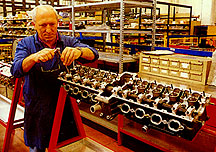
The unique cylinder block was made on special Swiss tooling, and is a single aluminium alloy casting with twin steel crankshafts running through its centre. These cranks are made by the French race and prototype engine company Mobilor, and have huge gears that feed power to the longitudinally mounted ZF gearbox. It is this configuration that gives the car its V16 T designation. A pair of pumps send and return the cooling fluid, and there are two big radiators as well. The engine is mounted transersely in the chassis a la Miura, and is also inclined 10 degrees forward to help keep the centre of gravity low and help it mate to the transaxle.
The internal architecture of the engine is simliar to the motor in the Lamborghini Urraco P300s. In fact, even the bore and stroke of 86.0 x 64.5mm are the same as this classic small block V8. The concept of the Cizeta motor shunts two such engines together nose-to-nose with the two timing chains in the centre. The thick liners in each bore suggest that capacity could easily be increased from the given 5,995cc.

There also two, four, eight or 16 of just about everything. Four cylinder-heads, each bearing twin-overhead camshafts, two fuel-injection systems, four distributors and 16 spark plugs. With eight camshafts, four-valves per-cylinder (64 valvs), and a 9.3:1 compression ratio, power output is a healthy 540bhp at 8,000rpm with 500 lbsft of torque at 6,000rpm.
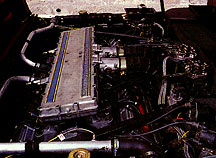
The engine management system of the later cars was bespoke, built by a company in Bologna staffed by ex-Weber-Marelli people. Earlier cars, however, used twin Bosch K-Jetronic systems.
Having run his exotic Italian supercar workshop in Los Angeles in a very hands-on manner, Zampolli was well aware of the servicing problems designed into such cars. This is something he actively sought to avoid with the Cizeta, hence the huge clamshell engine cover that swings clear enough to make access as easy, if not easier as on the average family saloon. The engine itself was designed to eliminate a big proportion of the fussy maitenance requirements of normal Italian supercars.
The Cizeta's purposeful look is enhanced by the no-nonsense five-spoke, two-piece OZ Racing alloy wheels which are secured by a single centre locking nut. These are 9J and 13J x 17-inch and shod with 245/40ZR17 and 335/35ZR17 Pirelli P-Zeros. Between their sturdy spokes you can see the beefy four-pot calipers embracing 12-inch Brembo vented and slotted discs.
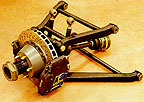
The suspension looks like something off a Group C racing car. Unequal length double wishbones, the fronts angled to provide anti-dive geometry, are controlled by coil springs and inboard Koni dampers that work via a linkage from the massive machined alloy hubs. There is an anti-roll bar on each axle, the front one being adjustable. At the rear, stout driveshafts run parallel to the ground. This is straightforward, traditional Italian supercar practice with no ABS, traction control or any other electrical wizardry. The only concession to ease of driving is the power-assistance for the ZF rack and pinion steering.
At a glance, the Cizeta bears a huge resemblance to Lamborghini's Diablo. Not surprising when you learn that Zampolli also used Marcello Gandini, who penned the Diablo around the same time.
The first design, which was resting in a corner of the workshop, was taken all the way to a full scale model. Unfortunately, it was rather too conservative, to the point of blandness. Zampolli gently told Gandini this by way of suggesting a few minor changes here and there. At this point, Gandini himself confessed to not liking it much either, and set to work on a fresh proposal which became the production model. The shape of the body was very much dictated by the layout of the car's underpinnings, and the huge transversely located power unit set the very wide 81 inch track. The rest of the car grew from there.
"If you compare us with Bugatti, the concepts are diametrically different," Zampolli explained. "I am building a simple concept, they are doing it the most dificult way. Cars like the Porsche 959 are really over-complex. Sporty, elegant, simple are our watchwords. If you want a luxury car, you buy a Mercedes. It is as simple as that. People who do that look for little noises, etc. Other supercars have electric everything. We do a good air-con but keep gadgets out."
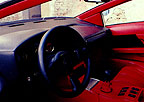
Minimalism is certainly evident in the plush leather trimmed cabin. Where there is normally a plethora of gadgets and instruments in such cars, here there is only a big tachometer and speedometer to look at. Other functions like water temperature and oil pressure are taken care of by idiotlights. "People don't look at gauges," Zampolli says. "So I decided to make things compact and simple with everything in front of you like a racing car. I love old Ferraris and they are like this."
"In interviews I gave in the late 1980's, I always said I would stay small," explained Zampolli. "The product we are building here is so exclusive that even at 50 cars a year I would have to hire a lot more people. It is hard to find skilled people at this level of quality." At the time of my visit in May 1993, Cizeta had delivered five cars and had six more underway.
"The maximum is 12 cars a year at this point, but if the market really picks up, I could expand to as many as 225 a year," Zampolli said. "Some people do a definite number, but I will build them as long as people want them. Cars like the Boxer and Countach were in production for around 10 years. We will make changes and improvements but have a car that will stay around for a long time."
Speed tests in early 1993 at Nardo were planned. European homologation would follow. Early cars were delivered to Far Eastern countries. In fact, Cizeta's Japanese importer, whom I met during my visit, was Mr. Nobuo Harada, owner of the famous Harada Collection of classic and famous sportscars.
Sadly, it was not to be. Not too many months after, with Japan still lingering from deep recession and the rest of the world not too keen on big money supercars, Cizeta's order book dried up. We are not quite sure when exactly the company stopped trading, but unlike Bugatti, its demise did not make big headlines. Cizeta went out with a whimper not a bang.
FOOTNOTE: Only 9 cars were built, 2 of which belong to the Sultan of Brunei. Two additional cars, #'s 10 and 11, are not quite finished, still in need of a bit of work, and are presently sitting in containers somewhere in Detroit as of 1998.
TECHNICAL SPECIFICATIONS
1991-1995 Cizeta Moroder V16T |
| ENGINE |
| Type |
90° V16T
DOHC, Transverse, Mid-Engine |
| Valves |
4 per cylinder |
| Capacity |
5,995 cc / 365.8 cu in. |
| Fuel system |
injection |
| Compression |
9.3:1 |
| Max power |
540bhp @ 8,000rpm |
| Max torque |
400 lb/ft @ 6,000rpm |
STRUCTURE |
| Body |
Aluminum |
| Chassis |
space frame chassis of elliptical chrome molybdenum steel tubbing |
| Suspension |
Independent, unequal length double wishbones, coil springs, inboard Koni dampers, anti-roll bars |
| Brakes |
Power assisted, four-pot calipers on 12" Brembo vented & slotted dics |
| Wheels |
two-piece OZ Racing cast alloy wheels
9J x 17" Front / 13J x 17" Rear |
| Front Tires |
245/40ZR17 Pirelli P-Zero |
| Rear Tires |
335/35ZR17 Pirelli P-Zero |
TRANSMISSION |
| Gearbox |
ZF 5-speed manual |
| Drive |
Rear |
| Final Drive |
2.97:1 |
PERFORMANCE |
| Top speed |
320 km/h |
| 0-100km/h |
4.5 sec |
DIMENSIONS |
| Overall Length |
2690mm / 105.9 in |
| Wheelbase |
2690 mm / 105.9 in |
| Rear Track |
2106 mm / 81 in |
| Weight |
1,700 kg / 3748 lb |
| Fuel Capacity |
120 L / 31.7 gal |
PRICE |
MSRP $800,000 |
\

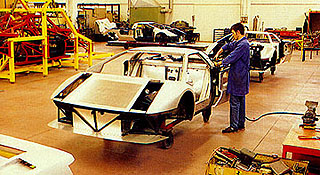
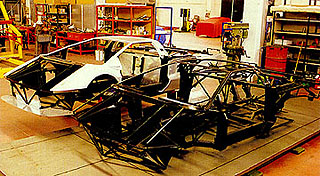
























I was met by Claudio Zampolli, Mr. Cizeta (pronounced Chey-Zeta, the way the initials CZ, Zampolli's initials, are spoken in Italian) himself. Totally laid back in the typical Italian way, Zampolli sat me down in his office and recounted his story in fluent English, with a Transatlantic twang. No surprise really, as one of the first things he revealed was that he and his family had lived in Los Angeles for many years.
A visible show of pride and allegiance to Italy and Modena is shown in the Cizeta company logo. For this, Zampolli adopted the city of Modena's colours, blue and yellow. The wolf's head logo is symbolic of the Tiberian she-wolf which fed Romulus and Remus, the orphaned children of Mars who founded Rome. To this, he added his own initials, CZ. The raised parts of the cam covers and the long intake plenum are also picked out in blue and yellow.
The unique cylinder block was made on special Swiss tooling, and is a single aluminium alloy casting with twin steel crankshafts running through its centre. These cranks are made by the French race and prototype engine company Mobilor, and have huge gears that feed power to the longitudinally mounted ZF gearbox. It is this configuration that gives the car its V16 T designation. A pair of pumps send and return the cooling fluid, and there are two big radiators as well. The engine is mounted transersely in the chassis a la Miura, and is also inclined 10 degrees forward to help keep the centre of gravity low and help it mate to the transaxle.
There also two, four, eight or 16 of just about everything. Four cylinder-heads, each bearing twin-overhead camshafts, two fuel-injection systems, four distributors and 16 spark plugs. With eight camshafts, four-valves per-cylinder (64 valvs), and a 9.3:1 compression ratio, power output is a healthy 540bhp at 8,000rpm with 500 lbsft of torque at 6,000rpm.
The engine management system of the later cars was bespoke, built by a company in Bologna staffed by ex-Weber-Marelli people. Earlier cars, however, used twin Bosch K-Jetronic systems.
The suspension looks like something off a Group C racing car. Unequal length double wishbones, the fronts angled to provide anti-dive geometry, are controlled by coil springs and inboard Koni dampers that work via a linkage from the massive machined alloy hubs. There is an anti-roll bar on each axle, the front one being adjustable. At the rear, stout driveshafts run parallel to the ground. This is straightforward, traditional Italian supercar practice with no ABS, traction control or any other electrical wizardry. The only concession to ease of driving is the power-assistance for the ZF rack and pinion steering.
Minimalism is certainly evident in the plush leather trimmed cabin. Where there is normally a plethora of gadgets and instruments in such cars, here there is only a big tachometer and speedometer to look at. Other functions like water temperature and oil pressure are taken care of by idiotlights. "People don't look at gauges," Zampolli says. "So I decided to make things compact and simple with everything in front of you like a racing car. I love old Ferraris and they are like this."






















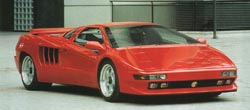





 Απάντηση με παράθεση
Απάντηση με παράθεση
 Ζήσε το σήμερα. Για το αύριο δεν ξέρεις.
Ζήσε το σήμερα. Για το αύριο δεν ξέρεις.



